Prototype & Prototype Chain
Prototype
Last day we have learned that every object has a second property called [[prototype]]. Similarly, every function has a second property known as the prototype, since functions are first-class citizens in JavaScript they can have their property. Today we're going to deep dive into prototype objects and prototype chains.
What is Prototype in JavaScript?
When a function is created, internally the JavaScript engine assigns a property prototype object to the function. This object is known as an anonymous object in JavaScript. This object also contains a property constructor that references the newly created function.
Since, every object has a second object (linked throgh [[prototype]]) this prototype object also linked to the Object.prototype object.
Lets create a function User():
function User(name) {
this.name = name;
}
new User();
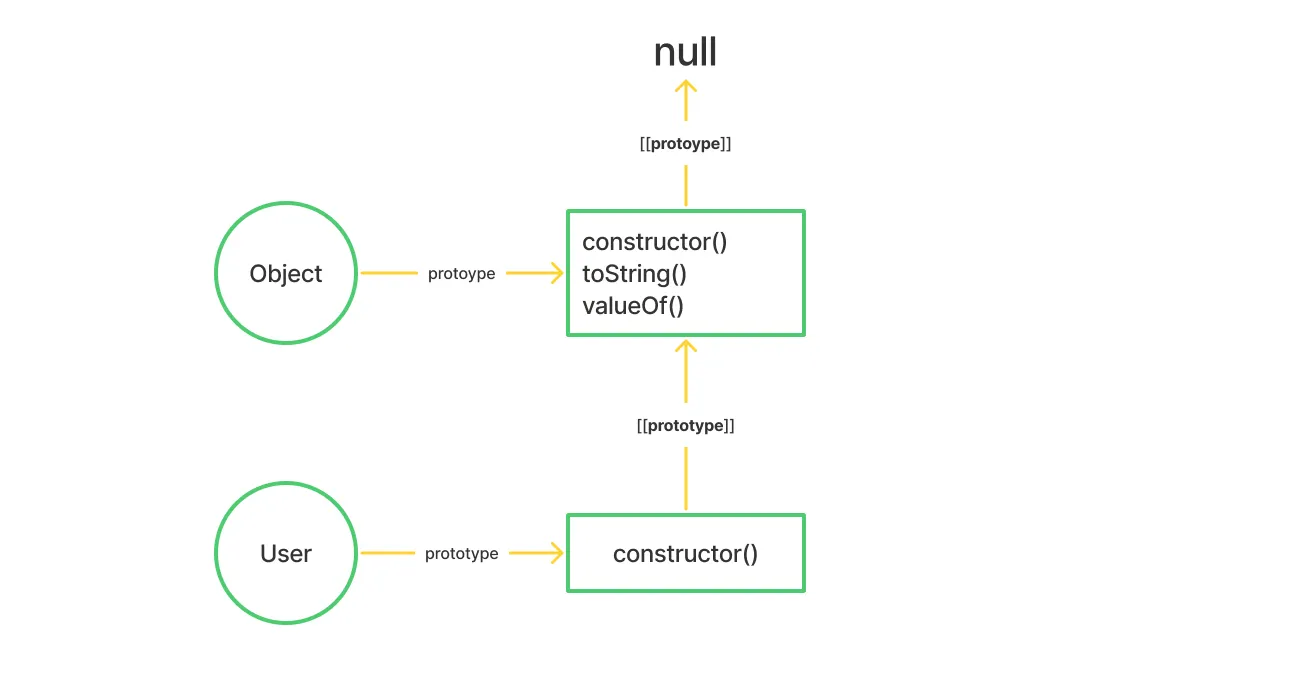
Before explaining the above example, let's pause for a moment to understand the Object.prototype:
Note
It might be quite confusing if this is the first time you've learned about the JavaScript prototype.
The Object() is a function, not an object.
That's why it has the Object.prototype object which contains all the methods for all the instances of Object.
Internally the Object.prototype object has a property constructor() that references the Object function.
console.log(typeof Object); // function
console.log(Object.prototype.constructor === Object); // true
So, we've learned that:
Object()is a function.- Every function has a prototype object that references the
Object.prototypeobject through the [[prototype]]. - This prototype object has a property named
constructorthat references the objects' function.
Object.prototype.constructor === Object; // true
Now, we have a good understanding of Object.prototype. Let's get back to the User() function example:
Like the Object() function, the User() function has a property called prototype (type of object). And this prototype object has a constructor property that references the User() function.
In addition, the JavaScript engine by default links the User.prototype object to the Object.prototype object through the [[prototype]] linkage, which is known as prototype chaining or prototype linkage. The prototype chain is denoted by [[prototype]]. Let's visualize the above example:
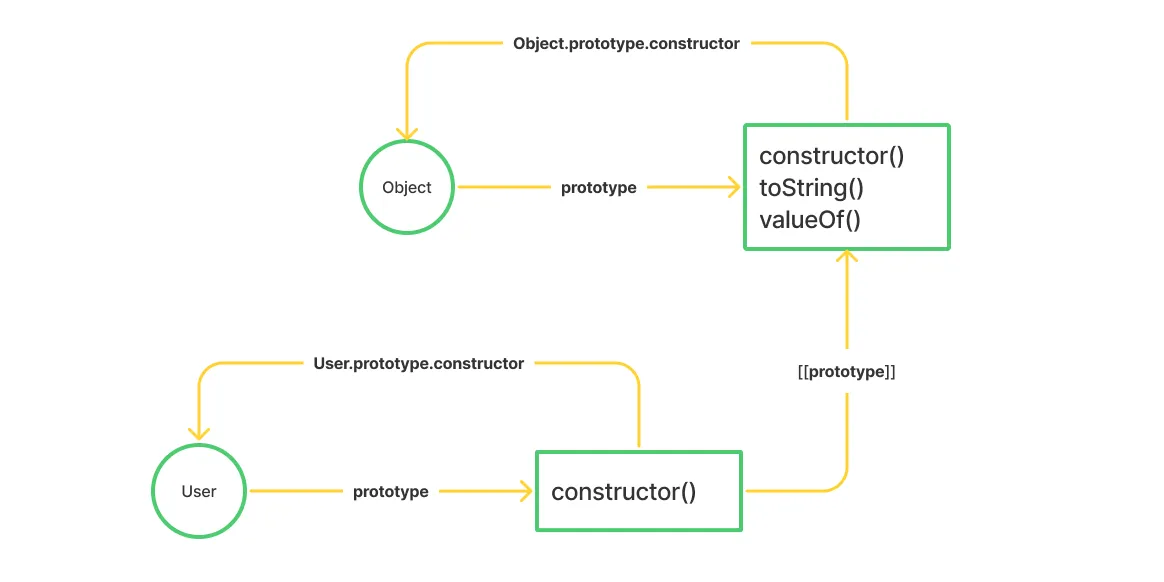
All right! let's confirm the linkage between the User.prototype and the Object.prototype:
console.log(User.prototype.__proto__ === Object.prototype); // true
console.log(Object.getPrototypeOf(User.prototype) === Object.prototype); // true
Beware
The __proto__ is deprecated in the browser environments. It is available on the server-side(node.js) for historical reasons.
To access the [[prototype]] object we have two methods:
Object.getPrototypeOf(obj)returns the [[prototype]] object of a given object.Object.setPrototypeOf(obj)sets the [[prototype]] of a given object.
Now, we have a solid understanding of what is a prototype in JavaScript. Let's quick recap before we dive into the usage of prototype.
- Every function has a prototype object. This prototype object references the
Object.prototypeobject by default through the [[prototype]] link. - The
Object.prototypeobject has the constructor property that references the Object's function. - The
Object.getPrototypeOf(obj)method returns the [[prototype]] object of a given object. - The
Object.setProtoypeOf(obj)method sets the [[prototype]] object of a given object.
info
Since, the Object.prototype.constructor references the Object() function, we can create new object with one of its instances.
Let's create a new object from one of an instance of User:
function User(name) {
this.name = name;
}
User.prototype.greet = function (msg) {
console.log(`${msg}, ${this.name}`);
};
const bob = new User("Bob");
const monika = new User("Monika");
const john = new bob.constructor("John"); // Creating new User without using the `User` function.
john.greet("Hello"); // Hello, John
Use of Prototype
In traditional object-oriented programming we use classes to store the shared methods and properties for all of its instances. But in the case of JavaScript, it is different, the constructor/prototype pattern is used to achieve the same goal before ES6. However, in ES6 we can use the class keyword like in other traditional object-oriented programming languages. But it is just the syntactic sugar, under the hood JavaScript uses the prototype to store the shared methods (all built-in JavaScript methods uses the prototype pattern).
Defining shared methods using class
class User {
constructor(name) {
this.name = name;
}
greet(msg) {
console.log(`${msg}, ${this.name}`);
}
}
const bob = new User("Bob");
const monika = new User("Monika");
bob.greet("Hello"); // Hello, Bob
monika.greet("Hi"); // Hi, Monika
We have created two instances (objects) of User and both of these objects have one property name. The method greet() is served from the User.prototype object. The greet() is neither available in bob nor monika.
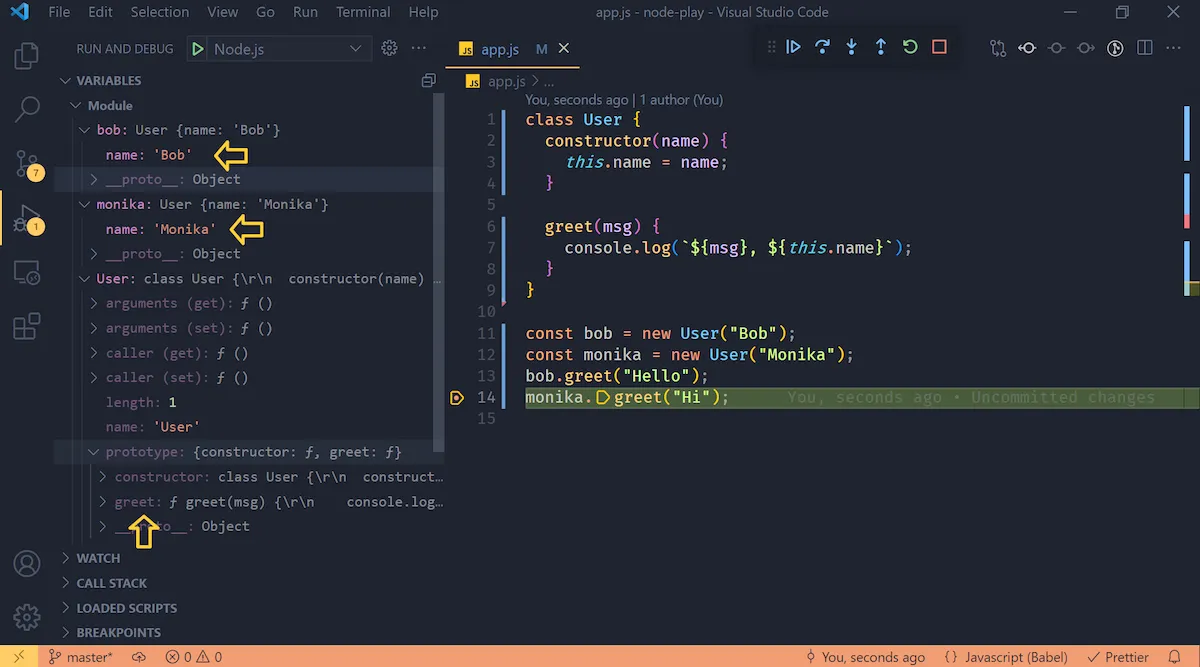
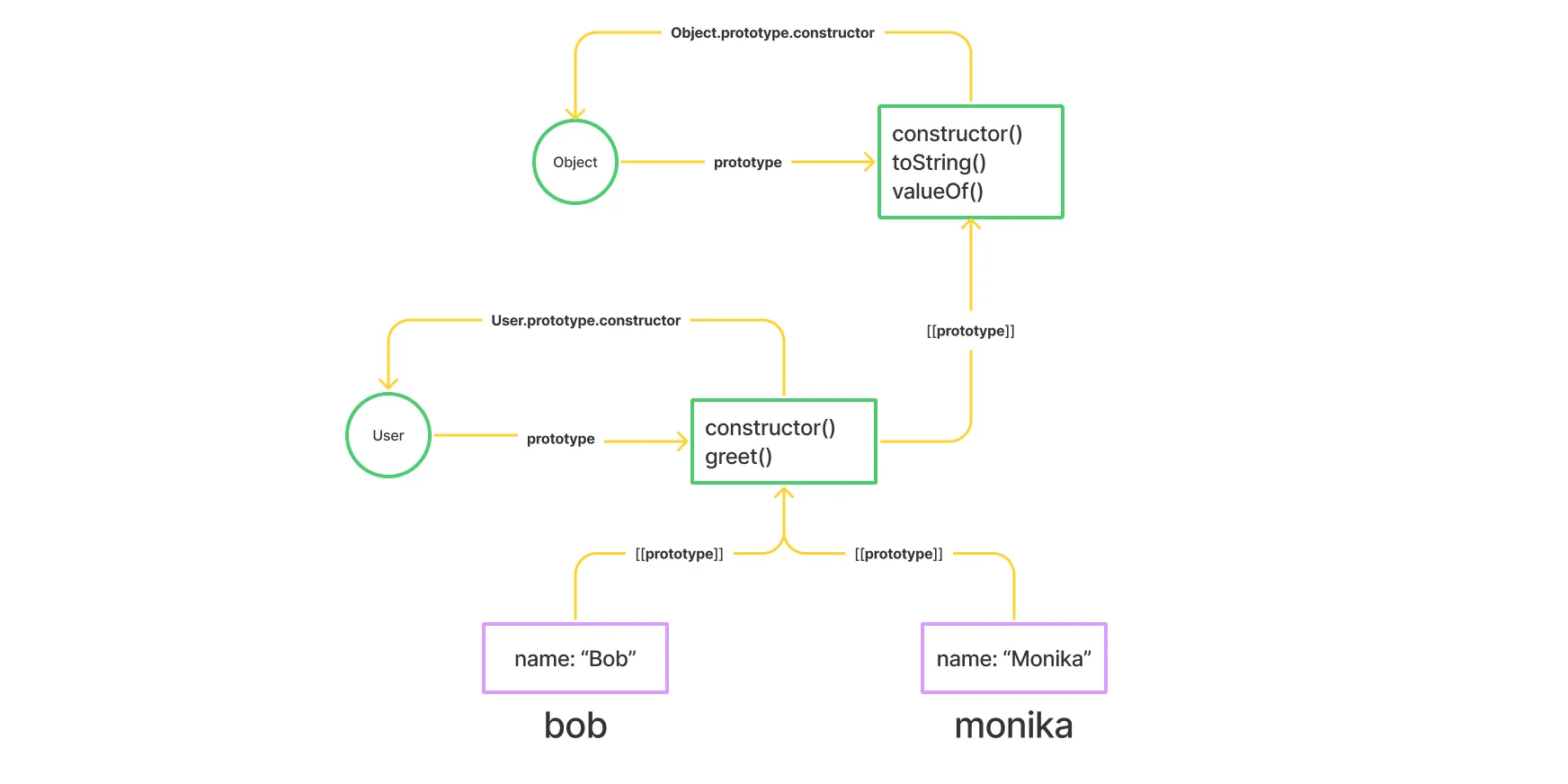
Defining shared methods using constructor/prototype pattern
function User(name) {
this.name = name;
}
User.prototype.greet = function (msg) {
console.log(`${msg}, ${this.name}`);
};
const bob = new User("Bob");
const monika = new User("Monika");
bob.greet("Hello"); // Hello, Bob
monika.greet("Hi"); // Hi, Monika
There is no difference between the class based implementation and constructor/prototype-based implementation, both are the same. The goal is to serve the methods from the prototype object, all built-in JavaScript methods are using the same implementation.
Advantages of Prototype
function User(name) {
this.name = name;
this.greet = function (msg) {
console.log(`${msg}, ${this.name}`);
};
}
const bob = new User("Bob");
const monika = new User("Monika");
The above example also made the greet() method available across all of the instances of User. But this way of creating objects is not recommended. The JavaScript engine have to re-create the greet() method whenever a new instance of User is created, it makes object creation slower.

That is why, in ES6 JavaScript under the hood uses prototypes to make the object creation faster. If methods are defined in the prototype then the JavaScript engine doesn't have to re-create those methods whenever a new instance is created.
Tip
To make object creation faster use ES6 class syntax to create objects or use constructor/prototype pattern whenever it is possible.
What if, if we have the same method in prototype and individual level of instances. For example:
function User(name) {
this.name = name;
}
User.prototype.greet = function (msg) {
console.log(`${msg}, ${this.name}`);
};
const bob = new User("Bob");
const monika = new User("Monika");
monika.greet = function () {
console.log("Hello, this is Monika");
};
bob.greet("Hello"); // ??
monika.greet(); // ??
This brings us to the next part of our discussion prototype chaining.
What is Prototype Chain
Whenever a new object is created the JavaScript engine by-default links that object to the Object.prototype object through the prototype linkage [[protoype]]. The link between the newly created object and the Object.prototype object is known as the prototype chain.
Let's visualize:
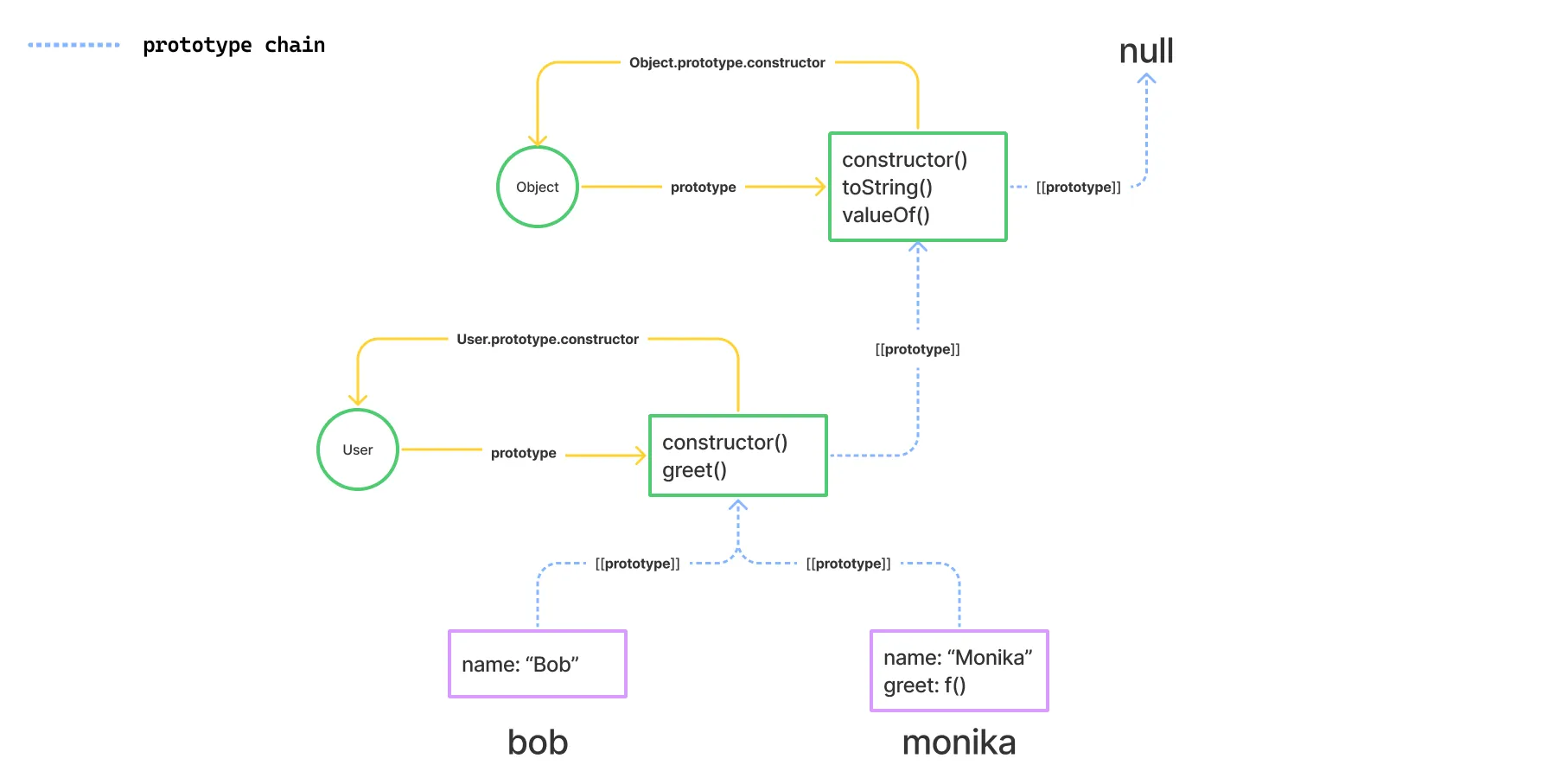
In the above example when bob and monika instances were created, the JavaScript engine links both of these objects to the User.prototype object through the [[prototype]]. Internally, the User.prototype object also linked to Object.prototype object also via the [[protoype]]. The whole link (prototype chain) is represented in the blue dotted line.
// bob and monika linked to User.prototype via [[prototype]]
console.log(Object.getPrototypeOf(bob) === User.prototype); // true
console.log(Object.getPrototypeOf(monika) === User.prototype); // true
// bob and monika shares the same User.prototype object
console.log(Object.getPrototypeOf(bob) === Object.getPrototypeOf(monika)); // true
// User.prototype linked to Object.prototype via [[prototype]]
console.log(Object.getPrototypeOf(User.prototype) === Object.prototype); // true
Alright! let's get back to our question what if we have the same method in prototype and individual level of instance?
So, before answering the question, let's try to understand what happens when we call bob.greet():
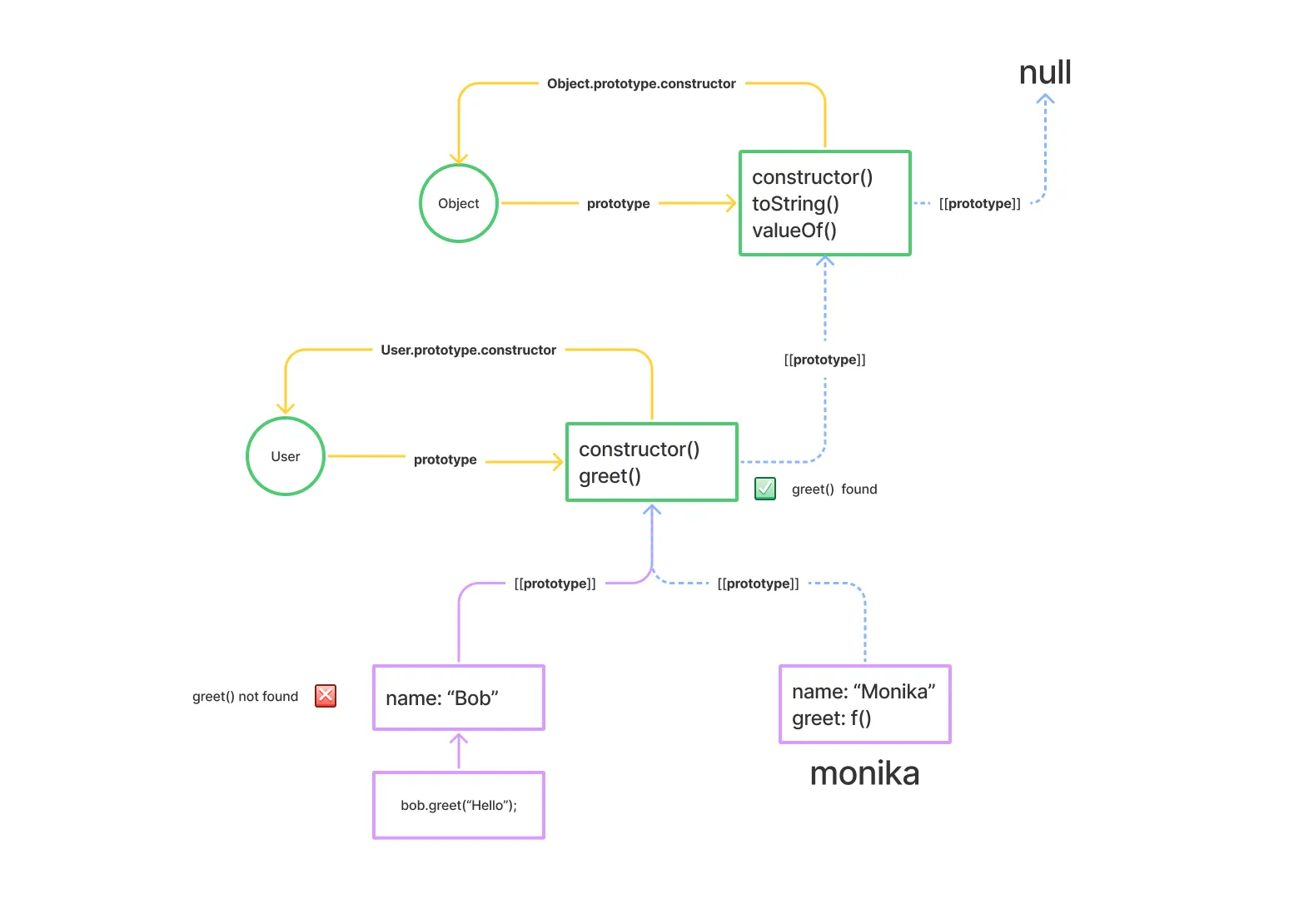
When the bob.greet() method is called, the JavaScript engine looks up the bob object and searches for the greet() method. Since, there is no greet() method, the JavaScript engine wents one level up and look up the User.prototype object and searches for the greet() method. Since the javascript engine can find the greet() method inside the User.prototype object (prototype chain) it executes the greet() method and return.
bob.greet("Hello"); // Hello, Bob
Similarly, when the monika.greet() method is called, the JavaScript engine looks it up at the monika object and searches for the greet() method. Since the JavaScript engine can find the greet() method inside the monika object it executes the greet() method and return.
monika.greet(); // Hello, this is Monika
note
This time the JavaScript engine did not look it up at the User.prototype object (prototype chain). Since the JavaScript engine can find the greet() method in the instance it executes the method immediately without looking it up in the prototype chain.
The question got answered: If we call a method, if the method is present at the instance level then it executes it from here. If the method is not available at the instance level then the JavaScript engine looks up at the prototype chain and execute the method from there. And if the method is not found anywhere in the prototype chain that goes up the Object.prototype it throws a TypeError.
monika.sing(); // TypeError: monika.sing is not a function
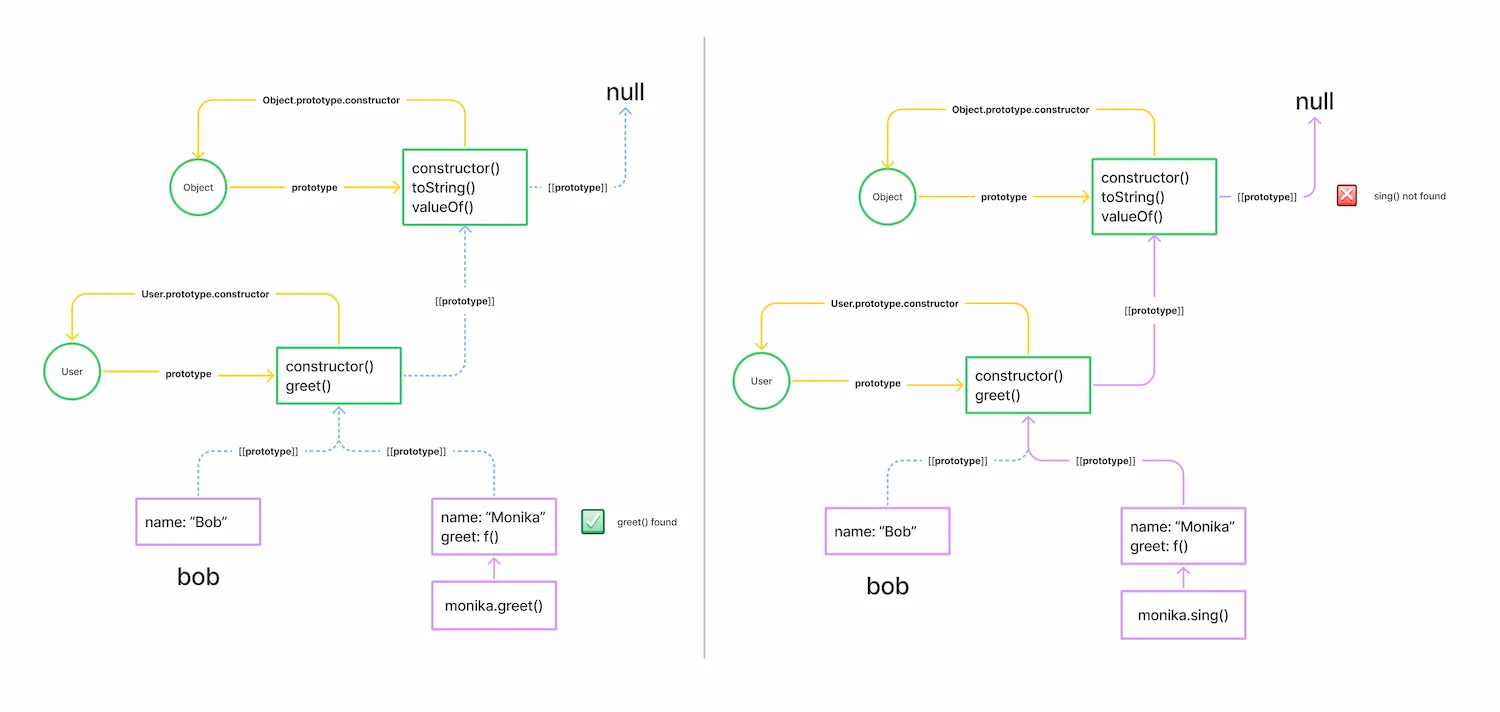
Summary
- Every function has a prototype object. This prototype object references the
Object.prototypeobject through the [[prototype]] linkage. - The
Object.prototypeobject has the constructor property that reference back to theObject()function. - The prototype chain allows instances(objects) to use the methods and properties of its prototype object through the [[prototype]] linkage.
- There are to methods available to access the [[prototype]] object:
Object.getPrototypeOf(obj)returns the [[prototype]] object of a given object.Object.setPrototypeOf(obj)sets the [[prototype]] object of a given object.
Resources
References
Articles
- 📖 Prototype in JavaScript: it’s quirky, but here’s how it works - Pranav Jindal
- 📖 Understanding JavaScript Prototype - Zell Liew